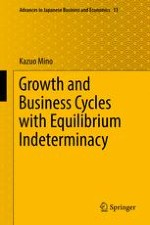2017 | OriginalPaper | Chapter
6. Indeterminacy in Open Economies
Author : Kazuo Mino
Published in: Growth and Business Cycles with Equilibrium Indeterminacy
Publisher: Springer Japan
Activate our intelligent search to find suitable subject content or patents.
Select sections of text to find matching patents with Artificial Intelligence. powered by
Select sections of text to find additional relevant content using AI-assisted search. powered by
